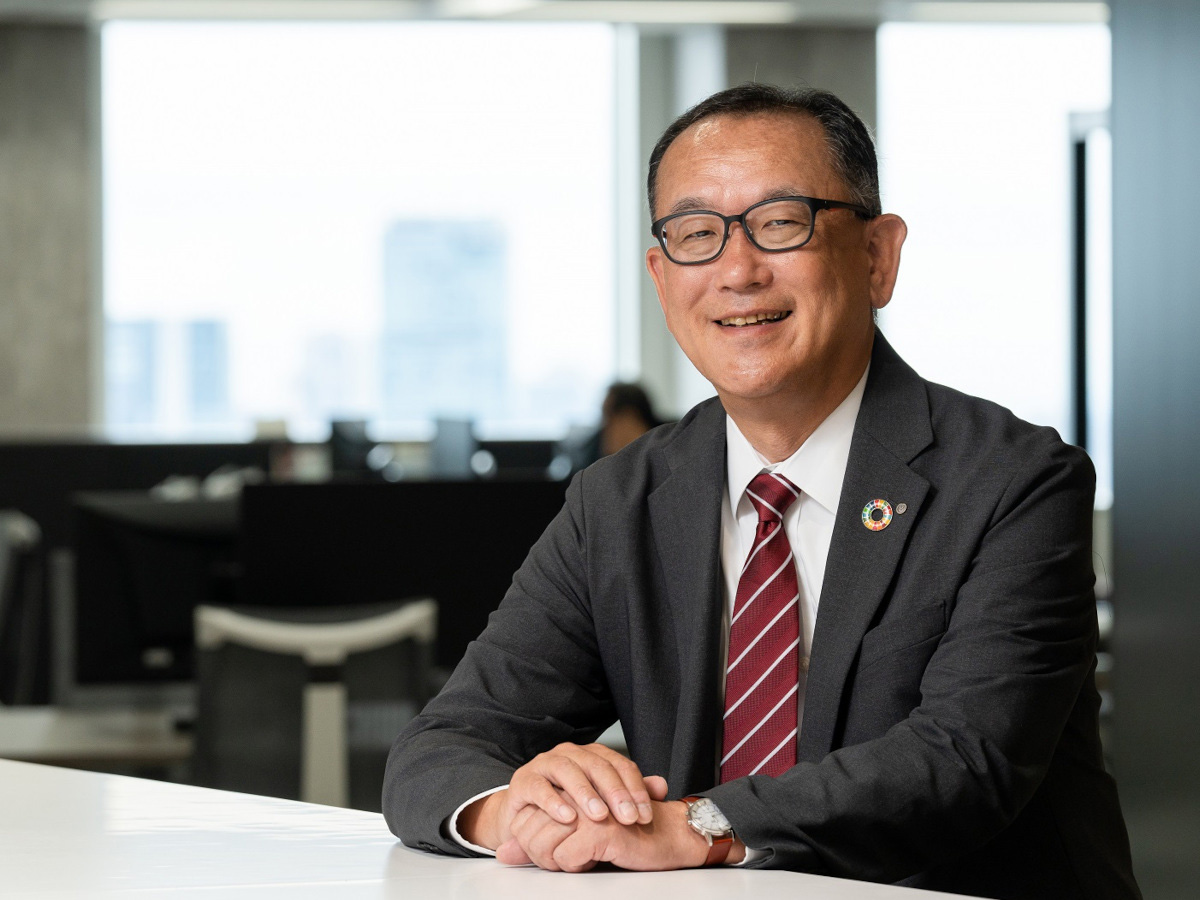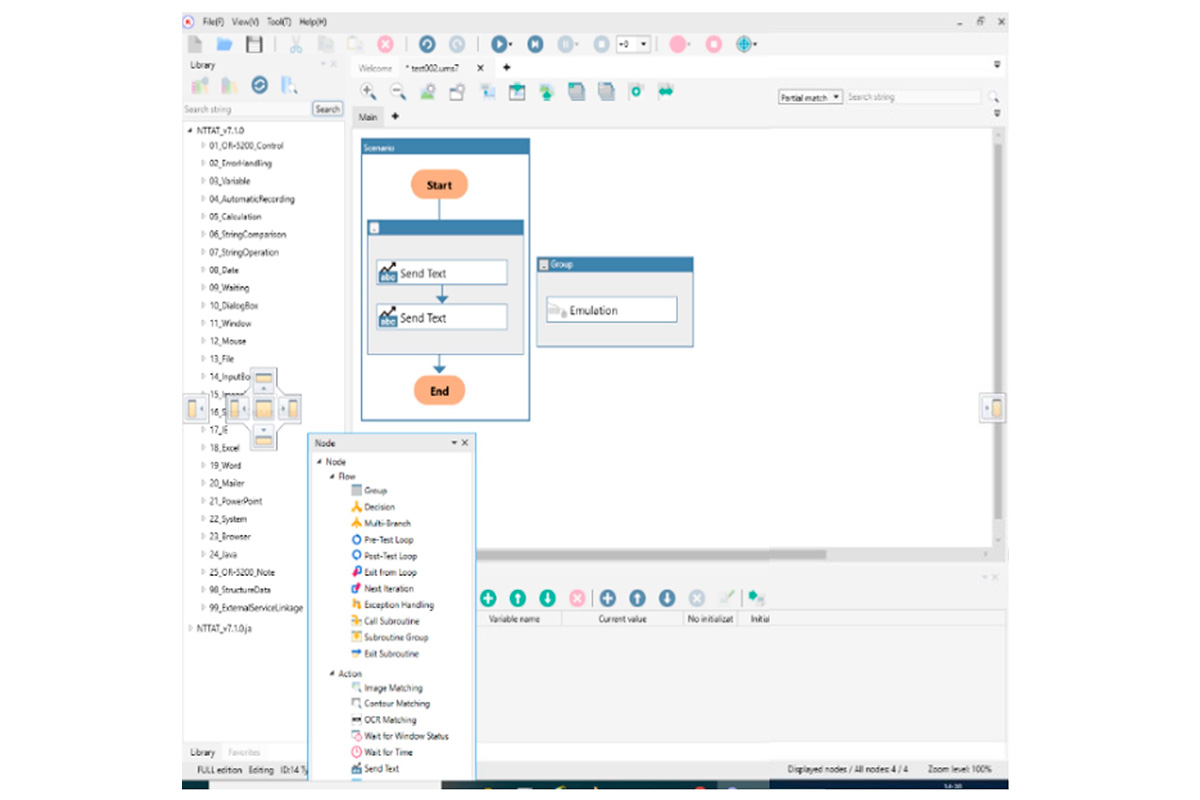NTT Advanced Technology discusses its mission to bridge cutting-edge research with business, address Japan's digitalization challenges, and expand its global presence in technology solutions.

Can you give a brief introduction to your business?
The mission of NTT Advanced Technology is to serve as the bridge between NTT Laboratories and the business. It aims to be able to create and develop a business out of the products of NTT Laboratories, which directs leading-edge research and technology development. We have been supporting the work of NTT Laboratories. To enhance those activities, we are shifting to do more marketing of their products, paying more attention to the business development side and producing a wide range of services and solutions.
Beluganos* is a technology developed by NTT Laboratories, but it is up to us to take it to another step by marketing it as a solution. The question we ask ourselves is, ‘What do we need in order to do that?’ Beluganos is simply a network OS system, a standard software. We know it will not penetrate the market if we just sell it. It is more than plainly selling the technology or the software. We believe that we must create an ecosystem of services for the entire lifecycle of that technology and how it can be useful to our clients. We should look at how we can systematize or market it and provide maintenance services and system integration elements. Furthermore, we are working on the initial stages of expanding our company’s machine, in which we focus on manufacturing the components of cutting-edge technologies, providing a total solution and responsibly marketing the whole package. From that perspective, we believe that our international business development is going to be increasingly important. Therefore, we will strengthen the globalization of our business.
*Beluganos is a new network OS designed for white-box switches, which can be applied to large-scale networks.
We have 2,050 employees. IOWN (Innovative Optical and Wireless Network) and other elements like security, AI, robotics, smart community, cloud and IoT, including the value of being global and co-creation, are the seven pillars with which we are expanding our business.
In our interview with Cyberlinks, we asked why DX has been so slow in Japan compared to other advanced countries. They said that it is because it is very difficult to standardize. Every client needing software in Japan wants their own system, making it hard to introduce these kinds of services to them. How do you approach that challenge when you introduce your software and systems?
There are many factors why digitalization has been slow in Japan. One is Japan's business environment being very analog and based on the principle of fine-tuning, which makes integrating digital solutions challenging. Another barrier to the advancement of DX is Japan's craftsmanship-based working style. Japan's working structure and recruitment standards are set in a way that makes it harder to quickly and easily let go of people.
Japan finally reached a critical point where it was forced to do things differently. Firms realized they couldn't continue to succeed due to the country's lacking and aging workforce and if they were to keep the analog-based fine-tuning style. We start to see that many are attracted to RPA software, which has become quite popular within the industry. Japan is propelling activities to digitize, automate and introduce robotics.
It differs from how digitization and automation of various work processes or workflow are developed in the US. In the US, the expansion and penetration of DX into working styles was motivated by seeking greater work efficiency and labor-saving methodologies to increase profit. The motives differ; the US was proactive, while Japan was more focused on reacting to the white-collar workforce. Introducing software such as WinActor, an RPA software, to solve non-productive and inefficient ways of working has been successfully integrated into the Japanese working environment. Now, we are at the next stage of doing more than just utilizing these technologies for the sake of efficiency. We want to use it more creatively and add value to the business.

WinActor, RPA tool
Many other advanced societies, like Germany, China, Italy and the United States, are starting to face very similar problems that Japan has been facing for the last 10 to 20 years in terms of demographic decline and recruitment. It is our view that the current macroeconomic climate, with the end being a historically low point, represents an interesting opportunity for Japanese firms to export these kinds of technologies and solutions to those types of countries. Do you agree with this premise?
I believe that this represents a great opportunity for Japan to contribute significantly to the world and widely market its technologies. Japan has immense strength in the technological field. It is a chance for Japan to demonstrate how these technologies can be positively used and add value to the business in many ways. It is a way to show many other businesses the level of success, profitability, and enrichment these technologies can offer for their business. We need to enable each company to experience the success of implementing DX into their processes, creating customized experiences for them and showing examples of success.
I think it is key to introduce DX and all these tools to help companies better manage their work. This can be powerfully utilized in many ways for internal management. Japanese industries have long been praised for having workers with high-level skills who continue to improve. The Toyota method is widely known worldwide because its skill level is successfully being implemented in manufacturing their products. If that know-how and rich expertise can also begin to infiltrate their management structure or working methodologies and processes, it could tremendously influence industries.
It has become a universal understanding in business management that the fit-to-standard model, SAP or SalesForce is crucial. The highest level of efficiency and optimization can be reaped as a result of fitting to the standard. However, I want to dissect that myth that has penetrated the industry with a surgical knife and ask, “Is that really the case?”
It is more important not to blindly believe that ERP is the standard and the only way to attain the highest efficiency level. Rather, ERPs should be used as tools to analyze your business and how these can help reach a level where you can create a new standard. That is the direction we should drive businesses to take, and we are trying to provide solutions for our clients in that regard.
Is there a particular example you would like to discuss in more detail or use Newsweek and Worldfolio platforms to promote to an international audience?
Our company is considered the department store of technologies, but the fact that our portfolio is vast shows that we don't have any specializations. We believe that simply having a wide and diverse portfolio won't lead to success, given the business style of this age. On that note, we are looking for areas to focus more on and prioritize.
We are going through a reorganization at the moment because our portfolio is too broad. Since we began to realize that having 13 business divisions is proving inefficient in some aspects and resulting in negative effects, we decided to consolidate that into four business domains and execute dynamic management beginning this fiscal year. The first business domain is total solutions, which includes IOWN technology and providing service integration for our clients. The second business division is applications, and its mission is to deliver DX services that use the “WinActor” RPA tools, energy management services, solution development and similar application-based types of business. The third one is our social platform or infrastructural services, which aims to give infrastructural support to the operations of technological development networks. Our fourth business domain is materials and nanotechnology, which is connected to the technologies of NTT Laboratories. They do significant research on devices and materials. This segment looks at ways to market and develop a business from the fruits of the research of NTT Laboratories in devices, materials and nanotechnology. Discovering how these different business domains can work together and which one to concentrate our efforts on will greatly help us to realize and bring the IOWN concept into the world. We aim to make that a multi-billion-yen business. One representative example of that is the rolling out of the Beluganos which is the network OS mentioned above.
Our second priority for growing our business is through the application domain. To achieve this, we plan to expand and market WinActor not just as a tool but as a comprehensive solution for local governments and communities. By positioning WinActor as a total solution, we aim to increase its adoption rate. We are exploring expanding its usage in local government processes, where government subsidies can be utilized. The integration of this software into paper-based tasks of local governments can be achieved through RPA.
Moreover, we use WinActor and various tools to provide solutions for disaster relief and recovery efforts for local governments. Japan is a disaster-prone country, so it places a lot of emphasis on disaster response and prevention. Many areas are also susceptible to flooding. Our company has a service that informs and warns local communities and governments about possible disasters through their mobile devices. We want to improve the quality and relevance of disaster-related information for the residents. It is already widely introduced in local governments, but we are looking to provide more personalized information.
Many local governments want services that take advantage of real-time information gathered by various agencies, such as Doppler Radars that monitor real-time rain and flood prediction data, meteorological information, cloud movements and patterns. The analysis of such information creates simulations to provide highly relevant data in case the residents need to evacuate. We aim to develop an application that can deliver services and information. The greatest merit of this application is the fact that we are utilizing GPS information based on cellular networks, which allows us to give the most relevant information to an individual. In some cases, evacuation may actually be more dangerous. Our goal is to be able to provide very personalized information, which determines the safest option for the residents.
We are hoping to contribute to a safe and secure lifestyle and the penetration of a smart society through this application that builds highly accurate hazard maps through real-time data. More than simply developing actual materials, components and technologies, we are conducting several initiatives because we want to continue to develop leading-edge technologies that enhance the competitiveness of the entity group. We would like to position ourselves as the "Advanced ICT provider” that provides integrated solutions based on the needs of our clients by our own responsibility.
This is a display system that can accurately depict ways in which light reflects upon an object in reality. The real objects reflect the light of different brightness and colors in different directions. Conventional display systems only express light reflection from a single point, but this system represents actual light reflection from multiple angles. It can become a powerful tool if we can create that reality in our display systems with our technologies. The material of the product and the environment can greatly affect it. Therefore, we want to work closely with our clients to see how this technology can be most applicable to their environment.
The key is usually believed to be achieving the most beautiful image in displays. We collaborate with a company called Innolux Japan, which has a display technology that controls the light direction from each pixel. We created such an interesting development by combining their technology with our image-processing technology. We are marketing this product to companies in the automotive sector, and industries that involve accessories and businesses that emphasize particular textures and materials. They may be able to utilize such displays and create business with partners in domestic and overseas. We provide this kind of interesting luster to the products through this display.

Innovative "luster" display
We possess several surface coating technologies, including materials that are anti-corrosive, waterproof, fireproof, or designed for controlled temperature applications. As a demonstration, we applied our super water-repellent material called HIREC to coat the tea strainer and it doesn’t leak water by making a water drop ball-shape. This material can also be applied to the tops of telecommunication towers and antennas and is environmentally friendly. One of our key initiatives is to increase awareness of these fascinating and distinctive technologies at our disposal.
Our three international strongholds are the West Coast, Shanghai and Singapore, where the primary business domain is selling optical devices such as our optical fiber cleaners. Based on our high domestic market share from WinActor, we began to see effective ways to market it overseas about three years ago. We found out that that approach toward digitization is totally different from our neighbours in other Asian countries. From that experience through our sales activities, we learned that we must change our business style and approach. Although we may have the most cutting-edge technology, it doesn't guarantee our success in the business. Showcasing and servicing solutions to our clients based on that technology is vital, as well as the ecosystem we provide that can be integrated into their supply chain. It is not just about selling parts and components, as we understood from our efforts to spread Beluganos.
In order to succeed in global operations, we should first promote our cutting-edge technologies and demonstrate our capabilities and technologies for clients overseas to see. Our goal is to collaborate with them to provide solutions based on such technologies and dispatch staff that can serve as a bridge in the local regions and roll out that business structure.
We began to work with NTT Data within the group company because it has a solid worldwide network and track record in global business. Through them, we can grow our global accounts. Establishing collaborations and alliances in the local areas is one of the things we want to pursue. Moreover, we also launched offices in Europe and Australia this October.
Imagine we come back in five years for your 6th anniversary as the president of the company and interview you again. What dreams and goals would you like to have achieved by then?
Although this may sound abstract, I want to be able to say that we were able to create something that was a game changer successfully. In five years, we want always to be the game changers in how we do business as well as our position within the NTT group. We have been using certain services and technologies we provide as a solution for our clients. In a sense, we rely upon other technologies and company services. I want our company to develop and utilize our game-changing technologies and services. Aside from creating new things in the market and supporting the entity’s activities, we want to be a business driver of the NTT group. In addition to our business model, we believe we need a definitive key technology that bears our core competitiveness within the next three years. It shouldn’t be just a black box technology; we want that to be more visible. This can place us in a good position concerning risk management and be more unshakable and resilient.
0 COMMENTS